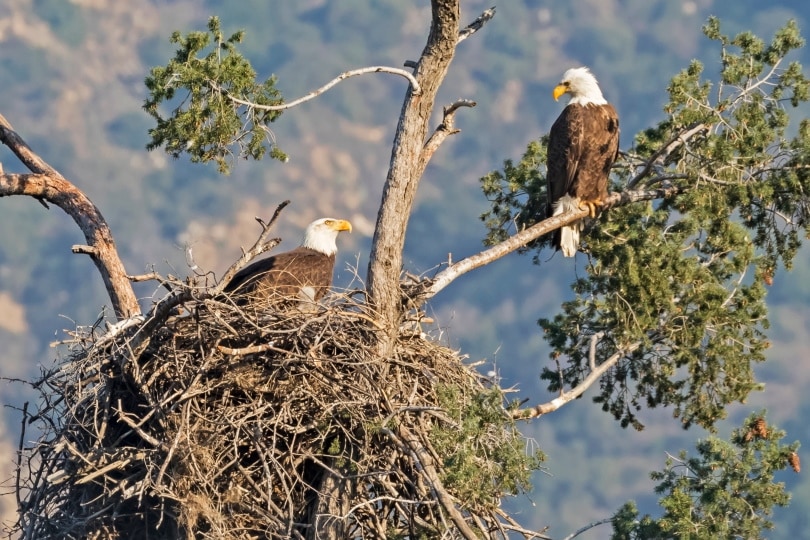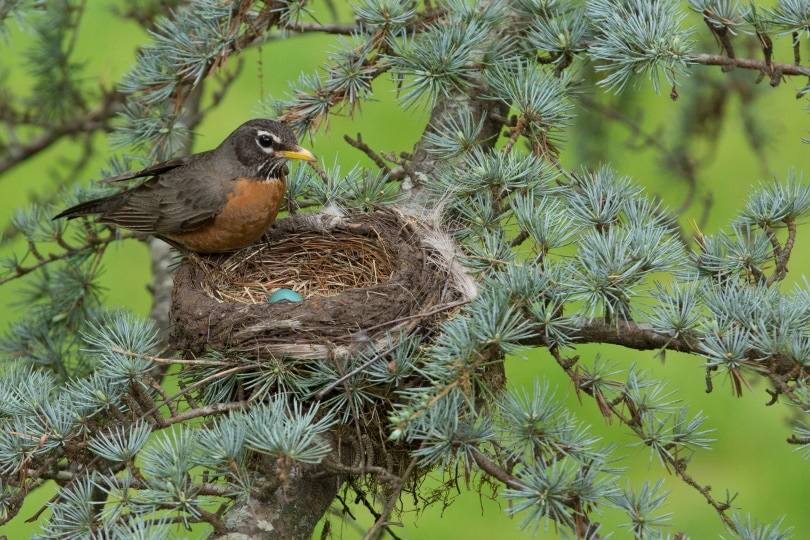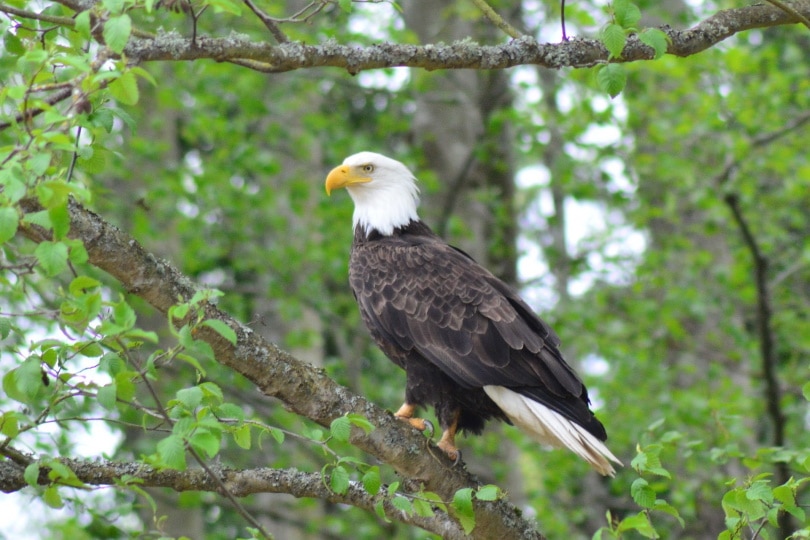How Long Do Birds Incubate Their Eggs? 8 Common Hatching Times
Last Updated on

Watching the birds in your yard can be entertaining and relaxing after a long work week. Birds serenade us with music, amuse us with their odd behavior, pollinate our plants, and consume many of the insects that make warm days unpleasant. While observing our feathered friends, you may have wondered, how long do birds incubate their eggs?
The incubation period depends on the species, but generally, smaller birds like those visiting your backyard incubate for 10 to 14 days, but larger birds can take up to a month or more to hatch. We’ll look at the incubation of several species and reveal the birds with the shortest and longest life cycles.

The Incubation Cycles of 8 Common Birds
1. American Robins

With its bright orange belly and gray back, the American Robin is a familiar sight for residents of the United States, northern Mexico, and Canada. Although they’re abundant in heavily forested areas, they also nest in urban and suburban neighborhoods. Robins are omnivorous, and their varied diet of worms, insects, and berries allows them to adapt to different environments. After the female lays eggs, they incubate for 12 to 14 days. The male takes over the parenting duties of feeding the fledglings for another 2 weeks. When the infants are 2 weeks old, they’re strong enough to fly.
2. Chickens

A quick incubation period is beneficial to farmers raising chickens, but they must wait a bit longer than the average incubation of a songbird. Although chicken mating and nesting seem like simple tasks, chickens are selective about their mates. Only the strongest, healthiest rooster is chosen as a partner. After a rooster mates with a chicken, the eggs take around 21 days to hatch. Chicks are covered with fine down for the first 6 to 8 days of their lives before they lose it and begin growing feathers.
3. Red-Tailed Hawks

Although they can live longer in captivity than in the wild, red-tailed hawks can live up to 25 years. As one of the largest raptors, the red-tailed hawk is an exciting bird to observe in flight. If you’re lucky enough to see the hawk’s mating ritual, you’ll see a unique display of high elevation acrobatics by the male and female. The pair will dive and clutch each other multiple times before the female decides her partner is the one.
After mating, the birds immediately begin gathering material for a nest at the top of a tree or even the platform of a billboard sign. The eggs incubate for 35 to 38 days, and the hatchlings will stay in the nests for up to 48 days before attempting their first flight. The parents share the hunting responsibilities to provide for their offspring.
4. Mallards

Although mallards are hunted more than any duck, they’re more abundant than other species. Mallards can live up to 20 years, but most wild ducks live for 3 to 5 years. After mating, the female selects a nesting area close to a water source. She creates a depression in the ground for the eggs and lines it with grasses and plant stems. Incubation lasts for 23 to 28 days, but the chicks only stay in the nest for 13 to 16 hours before exploring their new home.
Mallards in public parks are generally more friendly towards humans than ducks living near hunting grounds, but they can become irritated when someone approaches their territory during nesting. If you take walks around the park, you may encounter an angry mallard if the path leads you near the water’s egg. Nests are often near the shoreline, and some are constructed on floating vegetation.
5. Turkey Vultures

Also referred to as buzzards, turkey vultures are one of the most prolific winged predators in North America. They’re often seen floating in thermals without flapping their wings before descending to look for prey. The Turkey vulture is unique among large birds because of its heightened sense of smell. They can detect the gas produced by decomposing animals. Although they often hunt in groups, only one vulture feasts at a time. Vultures choose sheltered areas away from civilization to construct nests, such as caves, hollowed-out trees, and dense thickets.
The buzzard eggs incubate for 34 to 41 days, and both parents help keep the eggs warm. After 9 to 10 weeks, the infants are old enough to fly. Vulture parents have an effective way of keeping predators from the nest; they hiss and regurgitate on the invader. Since the diet of a buzzard consists primarily of carrion, the vomit defense usually repels the attacker.
6. Bald Eagles

Smaller birds have incubation periods that sometimes equal the fledgling stage, but birds of prey like the bald eagle take much longer to raise before they can fly. After dichlorodiphenyltrichloroethane (DDT) was banned in the United States in 1972, the bald eagle’s numbers increased significantly. In 1963, the population numbered only 417 nesting pairs, but by 2021, the population had risen to 71,467 pairs in 48 states.
Compared to other massive birds, eagles construct some of the largest nests. They can be up to 4 feet tall and 6 feet in diameter. The male and female collect material for the nest, but the female builds most of the nest herself. Incubations last for 34 to 36 days, but the lengthy nesting nestling period can last 98 days. Females only have one brood per year.
7. Anna’s Hummingbirds

In contrast to the eagle’s enormous nest, the Anna’s hummingbird nest is less than 2 inches in diameter. Hummingbirds are notorious for their love of nectar, but the birds also feast on tree sap, whiteflies, midges, and leafhoppers. The birds usually build nests on horizontal branches next to a nectar source, and their preferred species for nesting sites include sycamore, eucalyptus, oak, and poison oak. Females have two or three broods a year, and hummingbird eggs incubate for 14 to 19 days. After 23 days in the nest, the infants will attempt their first flight. Male and females do not form close bonds, and they typically use different partners for each brood.
8. Ostriches

Ostriches belong to the ratite group of flightless birds that includes emus, kiwis, cassowaries, and rheas. Unlike other farm animals like chickens and turkeys, ostriches have long spans of 40 years in the wild and 50 to 75 years in captivity. In a natural setting, an ostrich can lay up to 20 eggs (6 inches in diameter), but those in farming operations can lay 40 to 60 eggs a year. The incubation time can last 36 to 45 days, and both parents share the egg-warming and chick-raising duties. If a predator threatens the fledglings, the male lures the attacker away while the hen runs in the other direction with her young. Newborns from the world’s largest birds are similar in size to full-grown chickens.

Which Bird Experiences the Shortest Incubation Period?
Although rumors of incubation periods shorter than 10 days have been disproven, songbirds like the common redpolls, Lapland Longspurs, and yellow warblers have the shortest periods of 10 to 12 days. Hummingbirds have the smallest eggs, but their incubation time lasts 14 to 19 days.
Which Bird Experiences the Longest Incubation Period?
At 66 days, the longest incubation period belongs to the Laysan albatross. Honorable mentions with similar life cycles include the California condor with 50 to 60 days and the black-footed albatross at 65 days.

Conclusion
Most birds only incubate for a few weeks to a month, and the length of the incubation often correlates to the size of the bird but not always. Although mallards and Muscovy ducks are similar in size, mallards hatch after 28 days, but it can take up to 35 days for Muscovy eggs to hatch. Incubation variation is just as fascinating as the differences in parenting skills of each species. Vultures and ostriches, judging by human standards, are excellent parents, but hummingbirds, especially the males, seem less protective of their offspring. Like humans, some birds are more skilled at child-rearing than others.
Featured Image Credit: KGrif, Shutterstock
About the Author Robert Sparks
Robert’s obsession with all things optical started early in life, when his optician father would bring home prototypes for Robert to play with. Nowadays, Robert is dedicated to helping others find the right optics for their needs. His hobbies include astronomy, astrophysics, and model building. Originally from Newark, NJ, he resides in Santa Fe, New Mexico, where the nighttime skies are filled with glittering stars.
Related Articles:
How to Clean a Rifle Scope: 8 Expert Tips
How to Clean a Refractor Telescope: Step-by-Step Guide
How to Clean a Telescope Eyepiece: Step-by-Step Guide
Monocular vs Telescope: Differences Explained (With Pictures)
What Is a Monocular Used For? 8 Common Functions
How to Clean a Telescope Mirror: 8 Expert Tips
Brightfield vs Phase Contrast Microscopy: The Differences Explained
SkyCamHD Drone Review: Pros, Cons, FAQ, & Verdict
